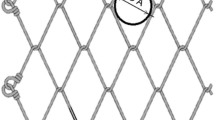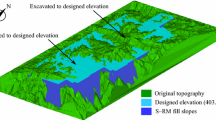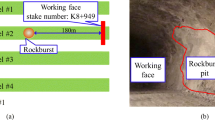Abstract
To examine how the number of rock blocks affects the rock-mass runout distance, large-scale outdoor rockfall experiments were physically performed using cubiform granite rock blocks on a slope prepared with granite slabs under both dry and water-saturated conditions. To learn more about the runout mechanism, numerical simulations were also conducted using three-dimensional DEM to reproduce the physical experiments under dry conditions. Longitudinal rock-mass runout distance between the gravity centre in the initial rock block assembly before failure and the apparent gravity centre at final deposition was 10 % larger for experiments under water-saturated conditions than those under dry conditions, with identical numbers of rock blocks in the physical experiments. The physical and numerical experiments revealed that rock blocks at the front and top surfaces had a longer runout distance than those at the rear and bottom surfaces. A rock block scarcely surpassed the rock blocks in front longitudinally and the rock blocks next to it laterally. The equivalent coefficient of friction between gravity centres was positively correlated with the number of rock blocks, which contradicts the findings of a negative correlation between the volume of sturzstroms (rockfall avalanches) and the equivalent coefficient of friction in classic studies on the long runout mechanisms. Our results were likely attributable to the fact that more kinetic energy was dissipated due to repeated inelastic intercollisions with other surrounding rock blocks and granite slabs when the initial rock-mass volume (number of rock blocks) was larger.












Similar content being viewed by others
References
Casagrande A (1971) On liquefaction phenomena. Géotechnique 21(3):197–202
Castro G, Poulos SJ (1977) Factors affecting liquefaction and cyclic mobility. ASCE J Geotech Eng Div 103(GT6):501–516
Cruden DM, Varnes DF (1996) Landslides, investigation and mitigation: special report 247. In: Turner AK, Schuster RL (eds) Landslide types and processes. Transportation Research Board, National Research Council, Washington, DC, pp 36–75
Cundall PA, Strack ODL (1979) A discrete numerical model for granular assemblies. Géotechnique 29:47–65
Ginsberg JH (1995) Advanced engineering dynamics, 2nd edn. Cambridge University Press, New York
Hakuno M (1997) Numerical simulation for failures. Morikita, Tokyo (in Japanese)
Hakuno M, Tarumi Y (1988) A granular assembly simulation for the seismic liquefaction of sand. Proc Jpn Soc Civil Eng 398(I–10):129–138
Hsü KJ (1975) Catastrophic debris streams, sturzstroms generated by rockfalls. Geol Soc Am Bull 86:129–140
Hutchinson JN (1986) A sliding-consolidation model for flow slides. Can Geotech J 32:610–623
Hutchinson JN, Bhandari RK (1971) Undrained loading, a fundamental mechanism of mudflows and other mass movements. Géotechnique 21:353–358
Ishihara K (1993) Liquefaction and flow failure during earthquakes. Géotechnique 43(3):351–415
Iverson RM (1997) The physics of debris flow. Rev Geophys 35:245–296
Iverson RM, LaHussen RG (1989) Dynamic pore-pressure fluctuations in rapidly shearing granular materials. Science 246:796–799
Kagawa T (1978) On the similitude in model vibration tests of earth-structures. Proc Jpn Soc Civil Eng 275:69–77 (in Japanese with English abstract)
Kiyama H, Fujimura H (1983) Application of Cundall’s discrete block method to gravity flow analysis of rock-like granular materials. Proc Jpn Soc Civil Eng 333:137–146 (in Japanese with English abstract)
Kiyama H, Nishimura T, Fujimura H (1994) An advanced distinct element model coupling with pore water. Proc Jpn Soc Civil Eng 499:31–39 (in Japanese with English abstract)
Mizuyama T (1979) Estimation of impulsive forces of debris flows to check dams and its problems. Shin Sabo (J Soil Eros Control Eng) 32(1):40–43 (in Japanese)
Ng TT, Dobry R (1994) Numerical simulations of monotonic and cyclic loading of granular soils. ASCE J Geotech Eng Div 120:388–403
Ohmachi T, Arai Y (1986) How to determine mechanical properties for distinct element method. J Struct Eng 32A:715–723 (in Japanese with English Abstract)
Okada Y (2011) Shear behaviour in numerical triaxial compression tests by 3D fluid-coupled DEM: a fundamental study on mechanisms of landslide initiation. J For Res 16:116–127
Okada Y, Ochiai H (2007) Coupling pore-water pressure with distinct element method and steady state strengths in numerical triaxial compression tests under undrained conditions. Landslides 4:357–369
Okada Y, Ochiai H (2008) Flow characteristics of 2-phase granular mass flows from model flume tests. Eng Geol 97:1–14
Okura Y, Kitahara H, Sammori T, Kawanami A (2000) The effects of rockfall volume on runout distance. Eng Geol 58:109–124
Poulos SJ (1981) The steady state deformation. ASCE J Geotech Eng Div 107(GT5):553–562
Sassa K (1996) Prediction of earthquake induced landslides, Special Lecture of 7th International Symposium on Landslides, “Landslides,” Trondheim, Norway, pp 115–132
Scheidegger AE (1973) On the prediction of the reach and velocity of catastrophic landslides. Rock Mech 5:231–236
Seed HB (1979) Soil liquefaction and cyclic mobility evaluation for level ground during earthquakes. ASCE J Geotech Eng Div 105:201–255
Shreve RL (1966) Sherman landslide, Alaska. Science 154:1639–1643
Shreve RL (1968) Leakage and fluidization in air-layer lubricated avalanches. Geol Soc Am Bull 79:653–658
Tarumi Y, Hakuno M (1987) A granular assembly simulation for the liquefaction of sand and quicksand. In: Bulletin of Earthquake Research Institute, University of Tokyo, vol 62, pp 535–577 (in Japanese with English abstract)
Uchida Y, Hakuno M (1988) Analysis of dry rock avalanches and debris flows by granular assembly simulation. In: Bulletin of Earthquake Research Institute, University of Tokyo, vol 65, pp 321–411
Acknowledgments
We thank Mr. Hiroyuki Miyajima (Yokoyama Rubber Co., Ltd.) for his immense help in preparing rock block assemblies and measuring the distance of each rock block in the experiments with 1,000 rock blocks. We also thank Drs. Hirotaka Ochiai, Toshiaki Sammori (Forestry and Forest Products Research Institute), and Prof. Sumio Matsuura (Disaster Prevention Research Institute, Kyoto University) for their valuable suggestions and advice on the analysis of rock block runout behaviour.
Author information
Authors and Affiliations
Corresponding author
About this article
Cite this article
Okada, Y., Uchida, I. Dependence of runout distance on the number of rock blocks in large-scale rock-mass failure experiments. J For Res 19, 329–339 (2014). https://doi.org/10.1007/s10310-013-0425-y
Received:
Accepted:
Published:
Issue Date:
DOI: https://doi.org/10.1007/s10310-013-0425-y




